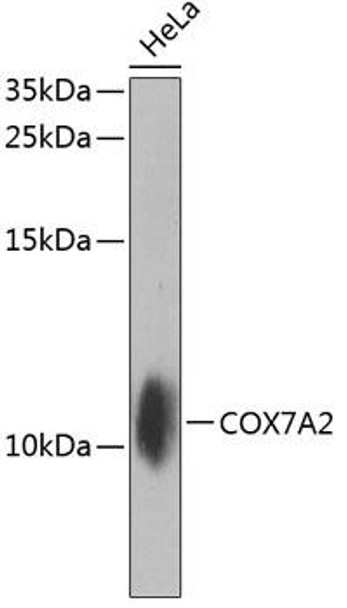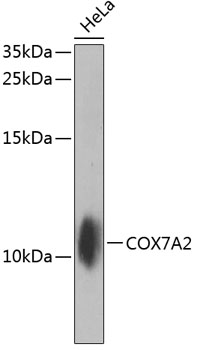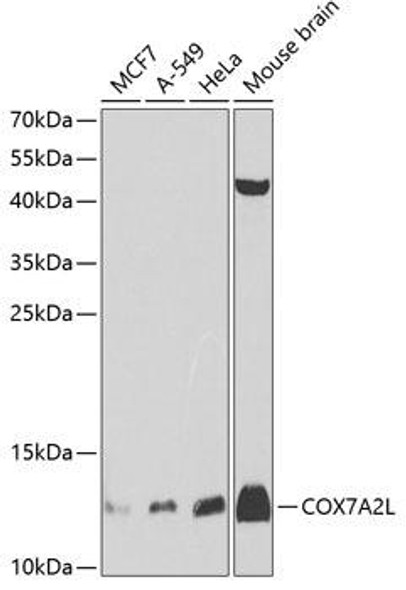Anti-COX7A2 Antibody (CAB8406)
- SKU:
- CAB8406
- Product type:
- Antibody
- Application:
- WB
- Reactivity:
- Human
- Host Species:
- Rabbit
- Isotype:
- IgG
- Research Area:
- Cell Biology
Frequently bought together:
Description
| Antibody Name: | Anti-COX7A2 Antibody |
| Antibody SKU: | CAB8406 |
| Antibody Size: | 20uL, 50uL, 100uL |
| Application: | WB |
| Reactivity: | Human |
| Host Species: | Rabbit |
| Immunogen: | Recombinant fusion protein containing a sequence corresponding to amino acids 33-115 of human COX7A2 (NP_001856.2). |
| Application: | WB |
| Recommended Dilution: | WB 1:500 - 1:2000 |
| Reactivity: | Human |
| Positive Samples: | HeLa |
| Immunogen: | Recombinant fusion protein containing a sequence corresponding to amino acids 33-115 of human COX7A2 (NP_001856.2). |
| Purification Method: | Affinity purification |
| Storage Buffer: | Store at -20°C. Avoid freeze / thaw cycles. Buffer: PBS with 0.02% sodium azide, 50% glycerol, pH7.3. |
| Isotype: | IgG |
| Sequence: | MLRN LLAL RQIG QRTI STAS RRHF KNKV PEKQ KLFQ EDDE IPLY LKGG VADA LLYR ATMI LTVG GTAY AIYE LAVA SFPK KQE |
| Gene ID: | 1347 |
| Uniprot: | P14406 |
| Cellular Location: | Mitochondrion inner membrane |
| Calculated MW: | 9kDa |
| Observed MW: | 11kDa |
| Synonyms: | COX7A2, COX7AL, COX7AL1, COXVIIAL, COXVIIa-L, VIIAL |
| Background: | Cytochrome c oxidase, the terminal component of the mitochondrial respiratory chain, catalyzes the electron transfer from reduced cytochrome c to oxygen. This component is a heteromeric complex consisting of three catalytic subunits encoded by mitochondrial genes, and multiple structural subunits encoded by nuclear genes. The mitochondrially-encoded subunits function in electron transfer, while the nuclear-encoded subunits may function in the regulation and assembly of the complex. This nuclear gene encodes polypeptide 2 (liver isoform) of subunit VIIa, with this polypeptide being present in both muscle and non-muscle tissues. In addition to polypeptide 2, subunit VIIa includes polypeptide 1 (muscle isoform), which is present only in muscle tissues, and a related protein, which is present in all tissues. Alternative splicing results in multiple transcript variants. Related pseudogenes have been identified on chromosomes 4 and 14. |
| NCBI Summary: | Tuftelin is an acidic protein that is thought to play a role in dental enamel mineralization and is implicated in caries susceptibility. It is also thought to be involved with adaptation to hypoxia, mesenchymal stem cell function, and neurotrophin nerve growth factor mediated neuronal differentiation. [provided by RefSeq, Aug 2014] |
| UniProt Code: | P14406 |
| NCBI GenInfo Identifier: | 14249851 |
| NCBI Gene ID: | 7286 |
| NCBI Accession: | BC008301 |
| UniProt Secondary Accession: | P14406,Q5T384, Q5T385, Q9BU28, Q9H5L1, B2RD57, D3DV21 D3DV22, |
| UniProt Related Accession: | Q9NNX1 |
| Molecular Weight: | 37,929 Da |
| NCBI Full Name: | Homo sapiens tuftelin 1, mRNA |
| NCBI Synonym Full Names: | tuftelin 1 |
| NCBI Official Symbol: | TUFT1 |
| NCBI Protein Information: | tuftelin |
| UniProt Protein Name: | Cytochrome c oxidase subunit 7A2, mitochondrial |
| UniProt Synonym Protein Names: | Cytochrome c oxidase subunit VIIa-liver/heart; Cytochrome c oxidase subunit VIIa-L; Cytochrome c oxidase subunit VIIaL |
| Protein Family: | Tuftelin |
| UniProt Gene Name: | COX7A2 |
| UniProt Entry Name: | CX7A2_HUMAN |









